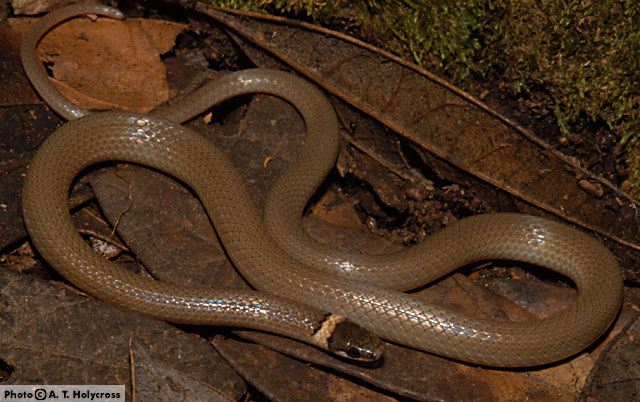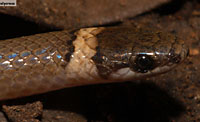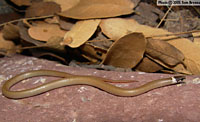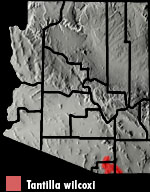Online Field Guide to The Reptiles and Amphibians of Arizona



Cochise County, AZ
 Cochise Co., AZ |
| CHIHUAHUAN BLACK-HEADED SNAKE Tantilla wilcoxi |
Mildly Venomous
|
| DESCRIPTION: A small (up to 350 mm or 14″ in total length) light tan or cream colored snake with dark gray-brown coloration on the top of the head. An off-white or pale cream collar bordered posteriorly by a thin gray-brown line crosses the neck and back of head. The light collar crosses the tips of the parietal scales (large plate-like scales on the back of the head) distinguishing this snake from other Arizona black-headed snakes. The dark head coloration extends down to the corner of the mouth and a small white patch marks each cheek just behind the eye. The belly is cream anteriorly grading to light pink or orange posteriorly. This snakes coloration and lack of dark markings on the belly distinguish it from the similar looking Ring-necked Snake. The scales are smooth and the small head is barely distinct from the neck. There are enlarged, grooved teeth in the rear upper jaw.
DISTRIBUTION: This snake is known from the Santa Rita, Patagonia, and Huachuca mountains of southeastern Arizona. It is found at elevations ranging from about 3,000′ to 8,000′. HABITAT: It inhabits Madrean Evergreen Woodland and Petran Montane Conifer Forest communities. Most specimens are found in heavily wooded canyons with abundant leaf litter and canopy cover.BEHAVIOR: This secretive ground-dweller spends most of its time burrowed under rocks, logs and leaf litter where it presumably forages for invertebrate prey. Most near-surface activity seems to occur on moist spring days. It hibernates during the cold months of late fall and winter.DIET: Venom is delivered to prey via enlarged, grooved teeth in the rear upper jaw (not considered to be dangerous to humans). It feeds on a variety of invertebrates.REPRODUCTION: Reproductive behavior is poorly known. It probably lays a small clutch (<4) of eggs in summer. By Thomas C. Brennan Gulf Publishing Co. Houston, TX Brennan, T. C., and A. T. Holycross. 2006. A Field Guide to Amphibians and Reptiles in Arizona. Arizona Game and Fish Department. Phoenix, AZ Fowlie. 1965. The Snakes of Arizona. Azul Quinta Press, Fallbrook, California Lowe, Schwalbe, Johnson. 1986. The Venomous Reptiles of Arizona. Nongame Branch Stebbins. 1985. Western Reptiles and Amphibians. Houghton Mifflin. New York, |
|
Visit Partners in Amphibian and Reptile Conservation:


HOME
Copyright © 2023, Arizona Game and Fish Department. All rights reserved.
If you make use of the textual contents of this site in reports, publications, etc. please cite and credit the author(s) and photographer(s). All photos on this website are copyrighted. However, those found in the species account section may be used for any noncommercial scientific, educational, or conservation purposes provided that photographs are not altered and continue to bear the copyright symbol and name of the photographer. Please contact the photographer regarding commercial use of copyrighted photographs.











